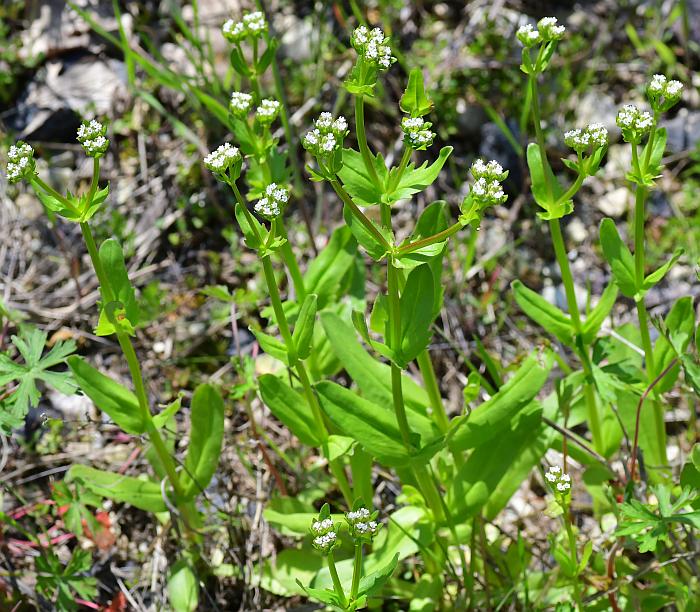Valerianella radiata (L.) Dufr.
Corn Salad

Native
CC = 0
CW = 0
MOC = 82
© SRTurner
Valerianella radiata (L.) Dufr.Corn Salad | |
 |
Native CC = 0 CW = 0 MOC = 82 |
© SRTurner |
|
Family - Valerianaceae Habit - Annual or occasionally biennial forb. Stems - Ascending to erect, to 40 cm, dichotomously branching, angled (the angles minutely winged), hollow, glabrous or with sparse retrorse pubescence on wing margins.
Leaves - Basal and opposite, simple. Basal leaves sessile or short-petiolate, spatulate to obovate, mostly rounded at the tip, the margins mostly entire, grading into the stem leaves; stem leaves mostly sessile, 1-10 cm long, often with the bases fused around the stem, oblong-spatulate to lanceolate, rounded to bluntly pointed at the tip, the margins often few-toothed near the base, glabrous or more commonly inconspicuously hairy along the margins and the midvein of the undersurface.
Inflorescence - Small, dense, headlike clusters, these usually paired at the branch tips, with small lanceolate to narrowly elliptic or narrowly spatulate bracts surrounding each cluster. Flowers sessile. Bracts ciliate-margined.
Flowers - Mostly perfect, epigynous, each subtended by a small bractlet. Calyces absent or reduced to a minute crown. Corollas actinomorphic, funnelform, 5-lobed, white, 1.5-5.0 mm long, the tube shorter than to about as long as the expanded upper portion, the tube often inconspicuously pouched at the base. Stamens 3, noticeably exserted from the corolla, the filaments attached near the top of the corolla tube, the anthers attached at their midpoint, white. Pistils 1 per flower, apparently of 3 carpels. Ovary inferior, with 3 locules, but only 1 of these fertile, with 1 ovule, the others empty. Style 1, the stigma usually slightly 3-lobed.
Fruits - Capsule 1.7-2.5 mm long, narrowly oblong-elliptic to more commonly ovate in dorsal view, glabrous, minutely hairy, or sparsely bristly-hairy, the fertile locule usually about as wide as the sterile ones, lacking a corky mass on the back, smooth or at most with a fine nerve or slight ridge, the sterile locules usually more or less parallel, with a shallow or more commonly relatively deep longitudinal groove between them.
Flowering - April - May. Habitat - Prairies, glades, savannas, fens, forest openings, streambanks, pastures, fields, roadsides, railroads, and open disturbed areas. Origin - Native to the U.S. Lookalikes - Other species of Valerianella (which are rare in most areas of Missouri). Other info. - This is a very common plant throughout most of Missouri except the northern third of the state, where it is apparently uncommon or absent. Missouri lies near the northwestern extent of the plant's natural range, which lies within the southeastern quadrant of the continental U.S. The plant is most easily recognized by its characteristic dichotomous branching, which usually produces inflorescences paired at the branch tips, and an even number of inflorescences overall. The inflorescences are tight clusters of white flowers and tend to be roughly rectangular. Species distinctions have traditionally relied on fruit morphology. Size, leaf size and shape, and amount of pubescence are all somewhat variable. The plant tends to be somewhat weedy and often occupies disturbed areas. Photographs taken in the Hercules Glade Wilderness, Mark Twain National Forest, Taney County, MO., 4-28-00 (DETenaglia); also at Weldon Spring Conservation Area, St. Charles County, MO, 5-4-2008, Al Foster Trail near Glencoe, St. Louis County, MO, 4-19-2010, Little Lost Creek Conservation Area, Warren County, MO, 4-19-2012, and near Labadie, Franklin County, MO, 5-19-2020 and 5-25-2021 (SRTurner). Photo of ovary cross section courtesy of George Van Brunt. |